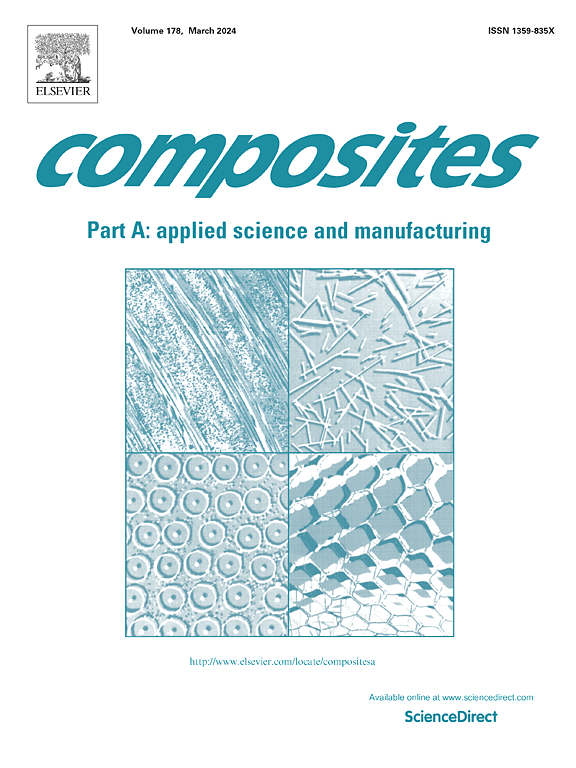TiC增强Al-Cu-Mg复合材料丝基搅拌摩擦添加剂制备:颗粒细化与分散
IF 8.1
2区 材料科学
Q1 ENGINEERING, MANUFACTURING
Composites Part A: Applied Science and Manufacturing
Pub Date : 2025-05-03
DOI:10.1016/j.compositesa.2025.109009
引用次数: 0
摘要
采用丝基搅拌摩擦增材制造技术(W-FSAM)制备了具有均匀分散纳米级TiC颗粒的致密铝基复合材料。提出了螺杆工具预塑化和搅拌销热塑化沉积的双步剧烈塑性变形驱动TiC颗粒破碎、破碎和再分散。结果表明,TiC颗粒在原料中由10 μ m的团聚体细化为平均粒径为58 nm的纳米颗粒,在基体中均匀分散。通过低热循环、动态再结晶和齐纳钉扎,TiC纳米颗粒获得了平均尺寸为0.75 μm的均匀等轴晶粒。亚微尺度等轴晶粒和TiC纳米颗粒使晶粒细化和Orowan强化,显著提高了力学性能。结果表明,该复合材料的平均屈服强度为203 MPa,极限抗拉强度为291 MPa,均匀伸长率为13.2%。这项工作为具有均匀分散和纳米级增强的铝基复合材料提供了有希望的见解,这对高级结构应用至关重要。本文章由计算机程序翻译,如有差异,请以英文原文为准。

Wire-based friction stir additive manufacturing of TiC reinforced Al-Cu-Mg composite: Particle refinement and dispersion
A dense aluminum matrix composite with uniformly dispersed nanoscale TiC particles was achieved using wire-based friction stir additive manufacturing (W-FSAM). Dual-step severe plastic deformation, featured with pre-plasticization in the screw tool and thermo-plasticized deposition by stirring pins, was proposed to drive the broken, fragmentation, and re-dispersion of the TiC particles. As a result, the TiC particles were refined from aggregation with 10 μ m in the feedstock to nanoparticles with an average size of 58 nm, achieving uniform dispersion in the matrix. Homogeneous equiaxed grains with an average size of 0.75 μm were also achieved due to the low thermal cycle, dynamic recrystallization, and Zener pinning of TiC nanoparticles. Sub-microscale equiaxed grains and TiC nanoparticles allowed for strong grain refinement and Orowan strengthening, significantly enhancing the mechanical performance. Consequently, the as-built state composite exhibited an average yield strength of 203 MPa, an ultimate tensile strength of 291 MPa, and a uniform elongation of 13.2 %. This work provides a promising insight into aluminum matrix composite with homogeneous dispersed and nanoscale reinforcement, which is critical for advanced structural applications.
求助全文
通过发布文献求助,成功后即可免费获取论文全文。
去求助
来源期刊

Composites Part A: Applied Science and Manufacturing
工程技术-材料科学:复合
CiteScore
15.20
自引率
5.70%
发文量
492
审稿时长
30 days
期刊介绍:
Composites Part A: Applied Science and Manufacturing is a comprehensive journal that publishes original research papers, review articles, case studies, short communications, and letters covering various aspects of composite materials science and technology. This includes fibrous and particulate reinforcements in polymeric, metallic, and ceramic matrices, as well as 'natural' composites like wood and biological materials. The journal addresses topics such as properties, design, and manufacture of reinforcing fibers and particles, novel architectures and concepts, multifunctional composites, advancements in fabrication and processing, manufacturing science, process modeling, experimental mechanics, microstructural characterization, interfaces, prediction and measurement of mechanical, physical, and chemical behavior, and performance in service. Additionally, articles on economic and commercial aspects, design, and case studies are welcomed. All submissions undergo rigorous peer review to ensure they contribute significantly and innovatively, maintaining high standards for content and presentation. The editorial team aims to expedite the review process for prompt publication.
 求助内容:
求助内容: 应助结果提醒方式:
应助结果提醒方式:


